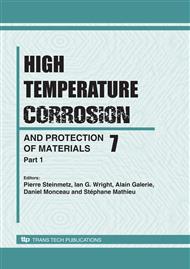p.419
p.429
p.439
p.449
p.463
p.473
p.483
p.491
p.501
Chemical Evolution in the Substrate due to Oxidation: A Numerical Model with Explicit Treatment of Vacancy Fluxes
Abstract:
To get a better understanding of oxidation behavior of Ni-base alloys in PWR primary water, a numerical model for oxide scale growth has been developed. The final aim of the model is to estimate the effects of possible changes of experimental conditions. Hence, our model has not been restricted by the classical hypothesis of quasi-steady state and can consider transient stages. The model calculates the chemical species concentration profiles, but also the vacancy concentration profiles evolution in the oxide and in the metal as a function of time. It treats the elimination of the possible supersaturated vacancies formed at the metal/oxide interface by introducing a dislocation density at the interface and in the metal bulk. This latter density can be related to the cold-working state. Its effect on the vacancy profile evolution is studied in the case of a pure metal. Eventually an extension of the present model to the oxidation of Ni-base alloys is discussed regarding a recent vacancy diffusion model adjusted on Ni-base alloys.
Info:
Periodical:
Pages:
463-472
Citation:
Online since:
September 2008
Price:
Сopyright:
© 2008 Trans Tech Publications Ltd. All Rights Reserved
Share:
Citation:


